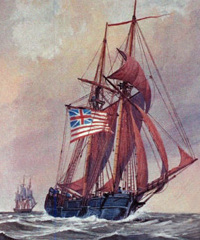USS Wasp (1775)

The Continental Navy Ship Wasp (note the Grand Union Flag)
|
|
| History | |
|---|---|
|
|
|
| Name: | USS Wasp |
| Acquired: | 1775 |
| Commissioned: | December 1775 or January 1776 |
| Fate: | Destroyed, September 1777 |
| General characteristics | |
| Type: | Schooner |
| Tons burthen: | 189 tons |
| Length: | gun-deck 74' 10" |
| Beam: | 24' 8" |
| Armament: |
|
| Service record | |
| Commanders: | Capt. William Hallock |
| Operations: | |
The Continental Ship Wasp was originally a merchant schooner named Scorpion, built at Baltimore, and purchased by the Continental Navy late in 1775, the first US naval ship to be given that name. She was outfitted at Baltimore during the winter of 1775–1776; and commissioned in December 1775 or January 1776, Capt. William Hallock in command.
Wasp set sail from Baltimore on 14 January 1776 in company with Hornet and a convoy of ships bound for the Delaware Capes. By virtue of their voyage to meet Commodore Esek Hopkins' squadron at the Delaware Capes, Wasp and Hornet appear to be the first ships of the Continental Navy to get to sea. They joined Hopkins' squadron on 13 February; and, four days later, the first American squadron to put to sea began its maiden voyage.
Interpreting his orders rather liberally, by ignoring those portions which related to operations in the Chesapeake Bay and along the southern coast of the colonies, Hopkins led his fleet directly to the Bahamas. The ships, minus Hornet and Fly, arrived at Abaco in the Bahamas on 1 March, and Hopkins began laying plans for the raid on New Providence. The fleet ran in to attempt a landing at the port of Nassau but failed to achieve surprise. The landing, therefore, went forward several miles to the east of the town. Wasp and Providence covered the Marines as they went ashore, but their guns never fired because the landing was not opposed. That afternoon, the landing force took Fort Montague and the following day captured the town of Nassau and Fort Nassau. They took a large quantity of cannon—close to 90 pieces, and 15 brass mortars—but the governor had managed to foil the mission in its primary objective by spiriting away the bulk of the gunpowder which had been stored there. Hopkins had to settle for 24 casks of powder out of the 174 originally stored there. The cannon and other military stores captured, however, more than justified the enterprise.
...
Wikipedia
